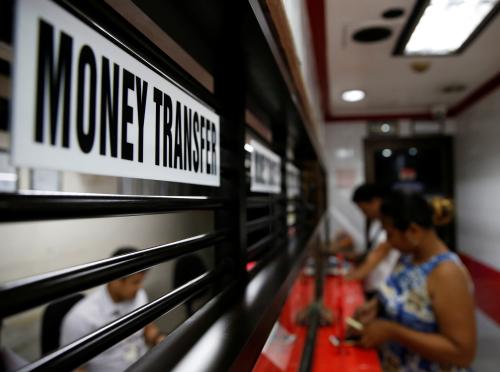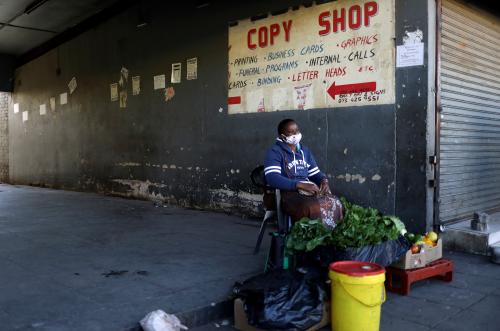Last year, remittance flows to low- and middle-income countries (LMICs) overtook foreign direct investment (FDI) as the largest source of incoming capital, having previously overtaken official development assistance (ODA) and private portfolio balance. This year though, the World Bank, in its recent report, “COVID-19 Crisis Through a Migration Lens,” predicts that remittance flows will decline by 20 percent globally as the coronavirus renders swaths of people unemployed across the world. The report attributes this trend in part to the fact that immigrants are a demographic particularly vulnerable to unemployment during crises. Moreover, the authors say, travel restrictions and flight cancellations have made pandemic-era labor markets particularly sticky.
Table 1 shows how past growth in remittances and the predicted decline in 2020 varies by world region. Remittance flows to sub-Saharan Africa are expected to shrink by 23.1 percent, which is a steeper drop than any other region except Europe and Central Asia; though, at approximately $48 billion per annum, sub-Saharan Africa also receives the lowest volume of remittances of any region. Notably, sub-Saharan Africa was one of the fastest-growing regions for remittances in 2017 and 2018, but remittance growth stagnated in the region in 2019.
Table 1. Remittance flows to low- and middle-income regions
Source: World Bank Group, “COVID-19 Crisis Through a Migration Lens”, April 2020.
Note: Values for 2019 are estimates, while values for 2020 and 2021 are forecasts.
According to the report, the role of remittances varies greatly from country to country. For example, at $23.8 billion, Nigeria received nearly half of the remittances sent to sub-Saharan Africa in 2019. South Sudan, however, is estimated to have the highest remittance flow as a percentage of GDP in 2019 (34.4 percent).
The report also states that it is more expensive to send money to sub-Saharan Africa than to any region in the world (though it is becoming more affordable over time), largely due to a lack of competition. In the last quarter of 2019, senders paid an average of 8.9 percent to send money to sub-Saharan Africa (remittance costs are typically reported as the fee one would pay as a percentage of a $200 transfer), a figure that is higher than the global average of 6.8 percent and well above the Sustainable Development Goal 10 target of 3 percent.
This average though, masks the vast differences in costs along remittance corridors (a “corridor” is a remittance pathway between two countries). Indeed, Figure 1 shows the five lowest-cost corridors and five highest-cost corridors for remittances sent to sub-Saharan Africa.
Figure 1. Sub-Saharan Africa’s five lowest- and highest-cost remittance corridors
Note: The vertical axis shows the cost of the remittance transfer as a percent of the transfer amount.
Source: World Bank Group, “COVID-19 Crisis Through a Migration Lens”, April 2020. Values for 2019 are estimates, while values for 2020 and 2021 are forecasts.
Notably, the United States was the country of origin for three of the five lowest-cost remittance corridors, while Mali was the top destination for two of the five. The two lowest-cost corridors, Côte d’Ivoire to Mali and Senegal to Mali, involve countries in the West African Economic and Monetary Union. Conversely, South Africa is one of the most expensive countries from which to send money: South Africa was the sender in three of the five most-expensive corridors within sub-Saharan Africa. It is also expensive to send money from South Africa to countries outside of sub-Saharan Africa: For example, in 2019, senders paid an average transaction fee of 25.1 percent to send money from South Africa to China.
For discussion on how to mitigate the impact of COVID-19 on remittances, consider reading the Brookings Future Development blog, “How to keep remittances flowing.” For more information on how to protect informal-sector incomes, see “COVID-19 and the future of work in Africa: How to shore up incomes for informal sector workers.”








Commentary
Figure of the week: Remittance flows to sub-Saharan Africa expected to slow after years of growth
June 25, 2020